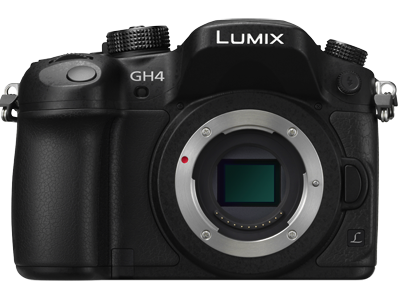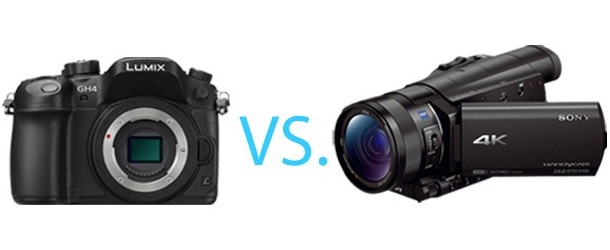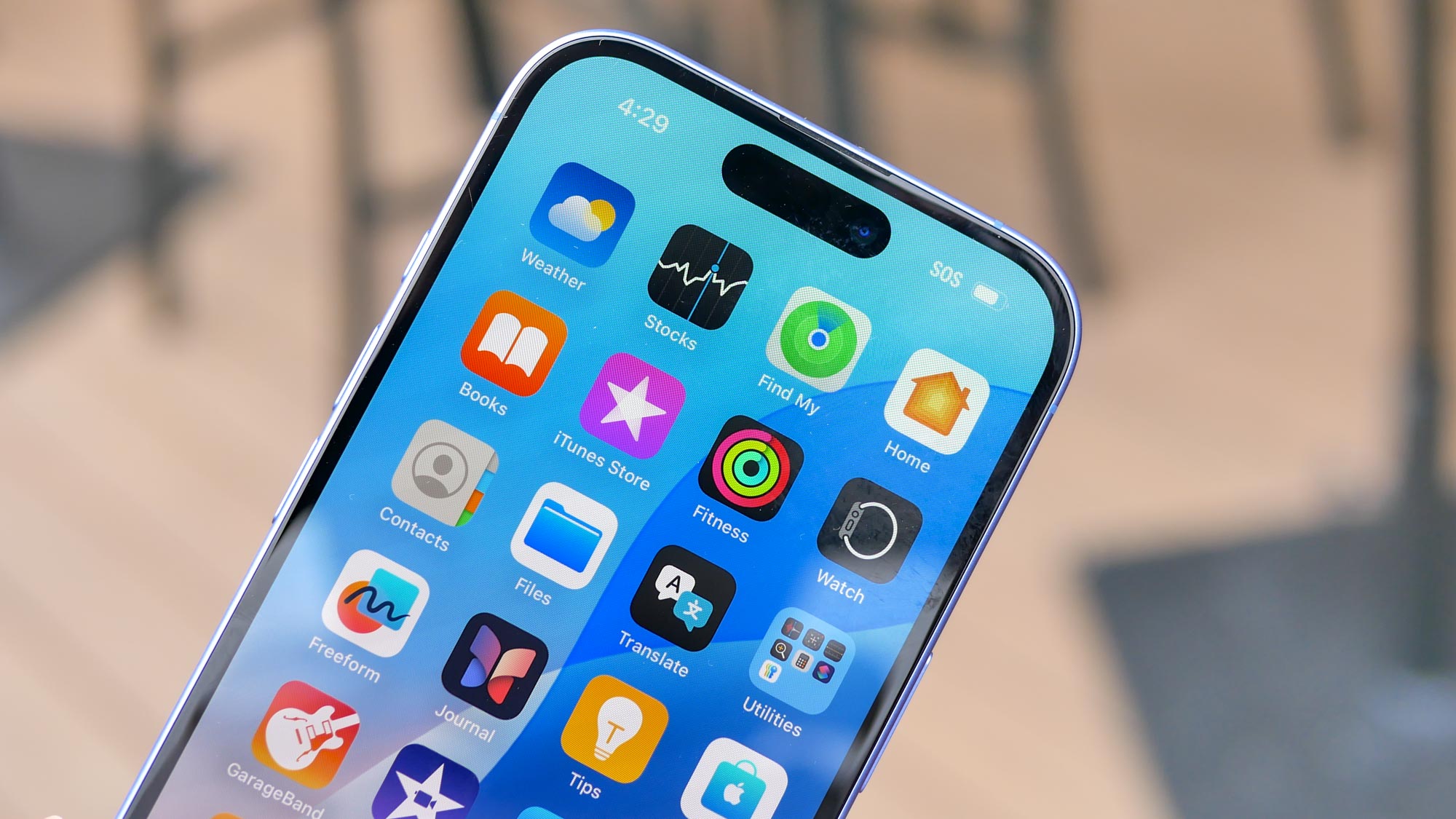Panasonic GH4 vs. Sony AX100: 4K Consumer Video Cameras
Both Panasonic and Sony are now selling cameras that capture 4K video. How do the company's offerings stack up, and which, if either, is right for you?


4K video might still be a nascent technology, but it's moving quickly into the mainstream. TV prices are dropping quickly; smartphones are starting to get 4K screens and 4K cameras, and now two semi-pro/consumer cameras are on the market: the $1,700 Panasonic Lumix GH4 and the $2,000 Sony FDR-AX100. (Yeah, neither name rolls off the tongue.) Both come at roughly the same price, but they offer very different experiences and capabilities, suitable for different types of buyers.
Let's look at how they compare.
| Row 0 - Cell 0 |
Panasonic GH4Sony AX100Body typeMirrorless (DSLR-style)CamcorderIncluded lensN/A
12X: 25mm-301mmPrice
$1,699.99$1,999.99Price with 12X zoom lens (approx.)$3,670 $1,999.99Sensor type and sizemicro four-thirds (225 square mm)1" (116 square mm)Still images16MP20MPVideo formatsUHD 3840 × 2160p at 30fps, 24fps1920 x 1080p at 60fps, 30fps, 24fps4K 4096 x 2160 at 24fpsUHD 3840 × 2160 at 30fps, 24fps1920 x 1080p at 60fps, 30fps, 24fps
Look and feel
For starters, they are different kinds of cameras. The Panasonic, as a micro-four-thirds mirrorless camera, is a 16MP still-camera that can shoot 4K video. The Sony AX100 is a 4K camcorder that can also take 20-MP still-images. As such, the Panasonic has the classic, tall DSLR-type shape that is best for photos, while the Sony has the long camcorder shape best for shooting video. Using either device for its secondary function will involve a bit of an ergonomic compromise. But shape in itself doesn't necessarily determine which is best for shooting 4K video.
MORE: Best Mirrorless Cameras 2014
Lens
In terms of lenses, the Sony AX100 has a fixed model that you can't swap out for another lens, but with a 12X zoom, from a wide 29mm to a very long telephoto of about 300mm (in 35mm equivalent), this lens probably covers all the range you'll need. It is also a pretty "fast" lens, with an aperture range starting from F2.8 at the wide end and from F4.5 at telephoto. These large apertures let in more light for low-light shooting and offer more flexibility in blurring out the background for shallow depth-of-field in a shot.
Price
The lens situation is critical to understanding the real prices of the two cameras. The Sony AX100 sells with its 12X zoom lens for $1,999.99. The Panasonic GH4 is an interchangeable-lens camera, and it sells for $1,699.99, body only. Then you have to purchase a lens. To roughly match the zoom range of the Sony, you'd need the $1,800 Panasonic 14mm-150mm DSLR lens (28mm-300mm in 35mm equivalent), plus Panasonic's $170 DSLR to micro four-thirds camera adapter. Total price: $3,670. In exchange, however, the Panasonic offers far more flexibility. You may not need a 12X zoom — if so, you can chose shorter lenses that may have other bonuses, such as a larger range of aperture sizes. Or you could add a special-effect lens, such as a fish eye for an ultra-wide distorted look or a macro for an extreme close-up.
Sensor
The naming of sensor types is horribly confusing and inconsistent. The largest is called full-frame; the most common on DSLRs is called APS-C. Others are measured in ratios such as 1/2.3. So some translation is in order.
On all its mirrorless cameras, Panasonic uses a sensor type called micro four-thirds, which measures 21.6 x 17.3 millimeters, for a total area of 225 square millimeters. Sony's AX100 camcorder uses what's called a 1" sensor, measuring 15.86 x 13.2 millimeters, for a total area of 116 square millimeters. So the Panasonic has a distinct advantage, with a sensor nearly twice as big. Larger sensors tend to do better in low light (high ISO settings). But that's only a rule of thumb, as it depends on the quality of the sensor and the capabilities of the imaging processor. Without seeing footage of both cameras, it's hard to know which will actually perform better.
MORE: What Is 4K TV?
In any case, both sensors are far smaller than those of professional video cameras or DSLRs that shoot professional-grade video. Full-frame DSLRs, for example, have sensors measuring around 860 square millimeters, though none of them shoots 4K video.
Video formats
The two cameras are well matched in terms of video formats. Both support the version of 4K that TVs use — with a resolution of 3840 × 2160 pixels — also known as Ultra HD or UHD. Each camera shoots this resolution at both the 30 frames per second rate associated with a "video" look and the 24 fps style of movies. Each camera also shoots 1080p HD video at 60 fps, 30 fps and 24 fps.
The Panasonic GH4, however, also shoots the higher-resolution 4K that filmmakers use, with a resolution of 4096 x 2160 pixels at 24 fps.
Professional aspects
The Sony AX100 is really a consumer video camera, albeit for consumers with high-end ambitions. It could well be used to shoot a "real" movie that could get into a film festival. But this camera lacks some features that the pros want. Chief among them is the ability to change lenses, which the Panasonic GH4 does offer.
The Panasonic has other pro attributes, too, such as its support for full 4K at the 4096 x 2160 resolution pro filmmakers use. It also supports more bitrates in all of its video formats to give more flexibility to filmmakers. In addition, Panasonic sells a $2,000 adapter that provides the kind of advanced inputs and outputs that professional videographers use, such as dual XLR audio input ports and monitors to keep track of the audio level of each channel.
MORE: Where Can You Get 4K Video?
However, both cameras lack the ability to put out raw, or very lightly compressed, video. And that is one of the main differences between them and true professional cameras that cost many times more. With built-in compression to formats such as MP4, both cameras toss out much of the visual information that higher-end cameras capture. Furthermore, these consumer cameras use smaller sensors to capture the data than those in true pro cameras.
Bottom line
Both the Panasonic GH4 and Sony AX100 bring 4K video creation to the masses — at least those masses willing to make a medium-sized investment. The GH4 has more flexibility, however. Since it is based on a popular micro-four-thirds still camera design, it should offer solid still-photography as well as 4K and HD video options. Fully equipping it for video shooting raises the price considerably, due to the required lenses and adapters. But it can ultimately deliver pro-like features.
The Sony AX100 is really a camcorder with photography as an add-on. For the best photo performance, it would be better to buy one of Sony's digital cameras, such as the upcoming Alpha a6000. But Sony's camera is nicely packaged for a "prosumer" video enthusiast, including a powerful zoom lens included for the moderate $2,000 price.
Follow Sean Captain @seancaptain and on Google+. Follow us @tomsguide, on Facebook and on Google+.
Sign up to get the BEST of Tom's Guide direct to your inbox.
Get instant access to breaking news, the hottest reviews, great deals and helpful tips.
Sean Captain is a freelance technology and science writer, editor and photographer. At Tom's Guide, he has reviewed cameras, including most of Sony's Alpha A6000-series mirrorless cameras, as well as other photography-related content. He has also written for Fast Company, The New York Times, The Wall Street Journal, and Wired.
-
chicofehr I'll wait for the 60FPS to come out. Sony makes one that does 60FPS but it costs $5500!!!Reply -
d_kuhn Even assuming the output isn't so compressed that it looks like crap, theses are very much niche products... most consumers who purchase these cameras thinking "moar pixels... good" are going to be very unhappy with them, just working with the footage takes a high end machine. I have 4k cameras (Red Epic, Vision Research Flex4K) and have $15k in 2 PC's, 4k displays, and interface hardware (and 3 times that in enterprise storage hardware to archive footage) just to create infrastructure capable of efficient workflow (and I'm a scientist not a Cinema Pro... the pro's have even larger investments). A prosumer wanting to use these cameras will have to spend several times the cost of camera and lens (at a minimum) just to have a system capable of playing the footage at full resolution... and better figure on coughing up lots of $$$ for Adobe CC or Apple FCP and needed support tools. At the end of the day... $2000 or $3670 will be one of the cheaper parts of getting a 4k capable environment... heck I paid nearly $3500 just for a 60hz 4k display... ONE display.Reply -
Wild Biker Bill "...To roughly match the zoom range of the Sony, you'd need the $1,800 Panasonic 14mm-150mm DSLR lens (28mm-300mm in 35mm equivalent), plus Panasonic's $170 DSLR to micro four-thirds camera adapter."A couple of things wrong with this sentence.1. The referenced Panasonic lens is not 14-150mm, it is 14-140mm.2. It can be bought new for ~$630.00 USD, about a third of the referenced price.http://www.bhphotovideo.com/c/search?atclk=Zoom+Focal+Lengths_14-140mm&ci=17912&N=4196380428+4291296566+42612082143. It is native micro 4/3, so it needs no adapter to mount to the camera.Other than that the sentence was accurate.Reply -
frankbough "Without seeing footage of both cameras, it's hard to know which will actually perform better."....if you can't compare footage then why run this comparison?Reply -
Goyoman "Full-frame DLSRs, for example, have sensors measuring around 860 square millimeters, though none of them shoots 4K video."WRONG! Canon 1D/C was the first and is still the best DSLR 4K camera and has been for a year and half. I've shot three 4K projects using this cameraReply -
JoelHornbarger This is an idiotic review. There are so many things wrong with it.These cameras are completely different. Their only similarities are their 4k capabilities and the fact that they are both cameras. It ends there.You gave a point to the Sony by saying it has more mega pixels. The Sony has 20mp covering a sensor half the size and therefore the pixels are super small. Why do you think the top of the line Nikon and canon cameras have 35mm sensors with half as many megapixels than their cameras that cost thousands of dollars less? Because bigger pixels are better! So not only is the gh4's sensor twice the size but so are its pixels!You also state that you can't get better codecs out of either camera other than avchd. Wrong again. You can attach an external recording device to the gh4 and get uncompressed 10 bit 422 apple pro res and that's all most videographers and cinematographers working on a really tight budget will want and use due to the cost of raw let alone 4k raw.focus peaking, wave form, zebras, SDI, xlr, pl mount compatible for true cine lenses, the fact that you can control focus at all! You can use any passive lens you want with the purchase of a cheap adapter and a few active lenses with more expensive adapters, large sensor that actually gives you dof control, and countless other things that make it a far superior more professional tool. Just the fact that you can throw thousands of dollars into one of the cameras and what you get is what you get with the other is telling.This is Panasonics top camera in their lumix line! And ever since the gh2 they've compared these models to the canon 5ds and 7d in the video realm.The gh4 isn't a professional camera but it will be used by professionals and that's a fact but not one pro worth his salt will touch that Sony or ever even know it exists.So please stop insulting the gh4 and do some research man! People apparently read your stuff so please don't lead the astray.It comes down to this. Do you want a camera that does everything for you and shoots crappy 4k or do you want control, a system to buy into with professional features that has the capabilitie to shoot uncompressed cine 4k.Reply -
Jonathan Miller ReplyEven assuming the output isn't so compressed that it looks like crap, theses are very much niche products... most consumers who purchase these cameras thinking "moar pixels... good" are going to be very unhappy with them, just working with the footage takes a high end machine. I have 4k cameras (Red Epic, Vision Research Flex4K) and have $15k in 2 PC's, 4k displays, and interface hardware (and 3 times that in enterprise storage hardware to archive footage) just to create infrastructure capable of efficient workflow (and I'm a scientist not a Cinema Pro... the pro's have even larger investments). A prosumer wanting to use these cameras will have to spend several times the cost of camera and lens (at a minimum) just to have a system capable of playing the footage at full resolution... and better figure on coughing up lots of $$$ for Adobe CC or Apple FCP and needed support tools. At the end of the day... $2000 or $3670 will be one of the cheaper parts of getting a 4k capable environment... heck I paid nearly $3500 just for a 60hz 4k display... ONE display.
Even assuming the output isn't so compressed that it looks like crap, theses are very much niche products... most consumers who purchase these cameras thinking "moar pixels... good" are going to be very unhappy with them, just working with the footage takes a high end machine. I have 4k cameras (Red Epic, Vision Research Flex4K) and have $15k in 2 PC's, 4k displays, and interface hardware (and 3 times that in enterprise storage hardware to archive footage) just to create infrastructure capable of efficient workflow (and I'm a scientist not a Cinema Pro... the pro's have even larger investments). A prosumer wanting to use these cameras will have to spend several times the cost of camera and lens (at a minimum) just to have a system capable of playing the footage at full resolution... and better figure on coughing up lots of $$$ for Adobe CC or Apple FCP and needed support tools. At the end of the day... $2000 or $3670 will be one of the cheaper parts of getting a 4k capable environment... heck I paid nearly $3500 just for a 60hz 4k display... ONE display.
Even assuming the output isn't so compressed that it looks like crap, theses are very much niche products... most consumers who purchase these cameras thinking "moar pixels... good" are going to be very unhappy with them, just working with the footage takes a high end machine. I have 4k cameras (Red Epic, Vision Research Flex4K) and have $15k in 2 PC's, 4k displays, and interface hardware (and 3 times that in enterprise storage hardware to archive footage) just to create infrastructure capable of efficient workflow (and I'm a scientist not a Cinema Pro... the pro's have even larger investments). A prosumer wanting to use these cameras will have to spend several times the cost of camera and lens (at a minimum) just to have a system capable of playing the footage at full resolution... and better figure on coughing up lots of $$$ for Adobe CC or Apple FCP and needed support tools. At the end of the day... $2000 or $3670 will be one of the cheaper parts of getting a 4k capable environment... heck I paid nearly $3500 just for a 60hz 4k display... ONE display.
-
Jonathan Miller ReplyEven assuming the output isn't so compressed that it looks like crap, theses are very much niche products... most consumers who purchase these cameras thinking "moar pixels... good" are going to be very unhappy with them, just working with the footage takes a high end machine. I have 4k cameras (Red Epic, Vision Research Flex4K) and have $15k in 2 PC's, 4k displays, and interface hardware (and 3 times that in enterprise storage hardware to archive footage) just to create infrastructure capable of efficient workflow (and I'm a scientist not a Cinema Pro... the pro's have even larger investments). A prosumer wanting to use these cameras will have to spend several times the cost of camera and lens (at a minimum) just to have a system capable of playing the footage at full resolution... and better figure on coughing up lots of $$$ for Adobe CC or Apple FCP and needed support tools. At the end of the day... $2000 or $3670 will be one of the cheaper parts of getting a 4k capable environment... heck I paid nearly $3500 just for a 60hz 4k display... ONE display.
Yeah that's what they said about HD when it came out, and DVD before that, and DV before that. The bottom line is you can never have too many pixels. If 4K is shipping then I want 8K, and I'm already thinking about 16K. -
colsub Here https://www.youtube.com/playlist?list=PLJAlQaKQ1_wSpV3baH87H8bQ1K0QR3TYi I find a promotion clip of this camera. Instead here https://www.youtube.com/watch?v=wtjRKMTcPtg a first look video in 4K UHD quality!Reply
